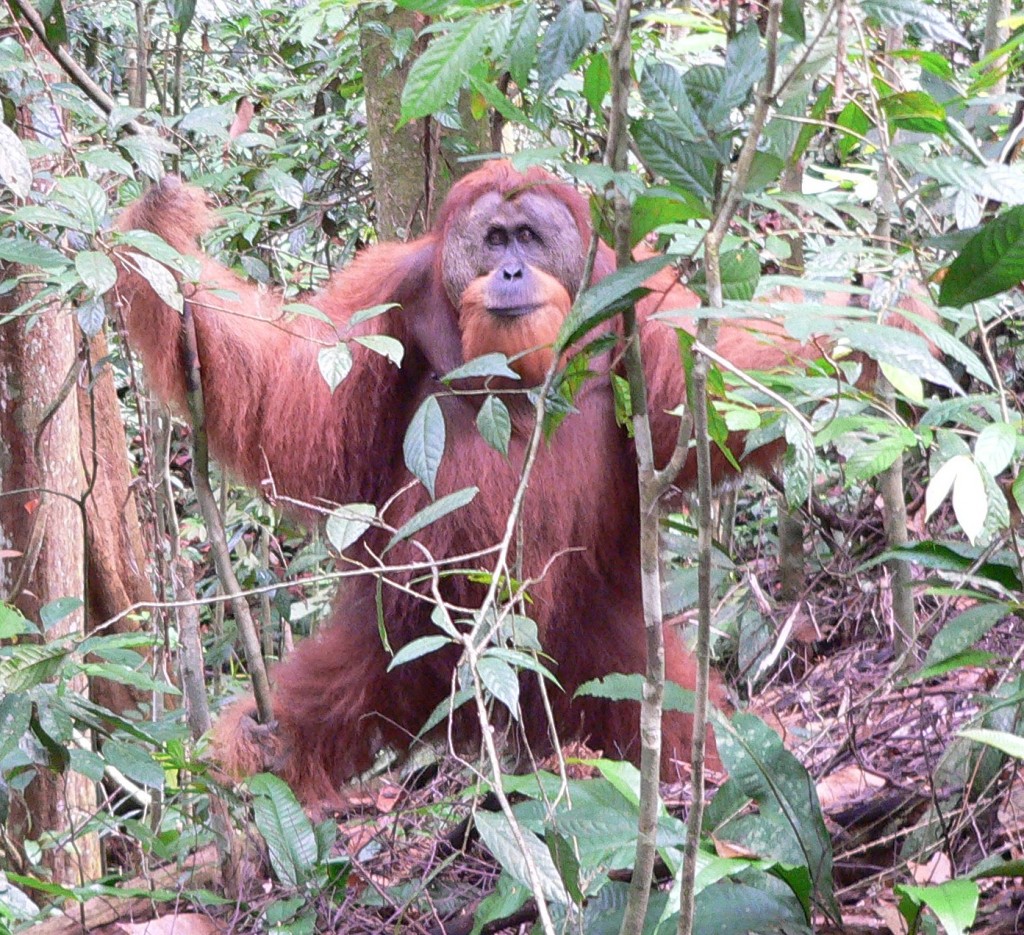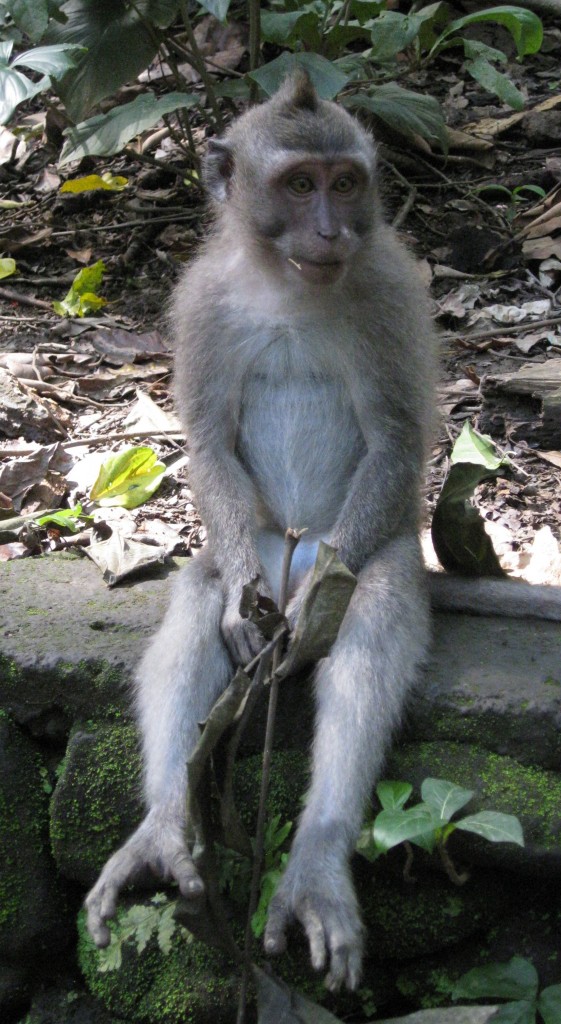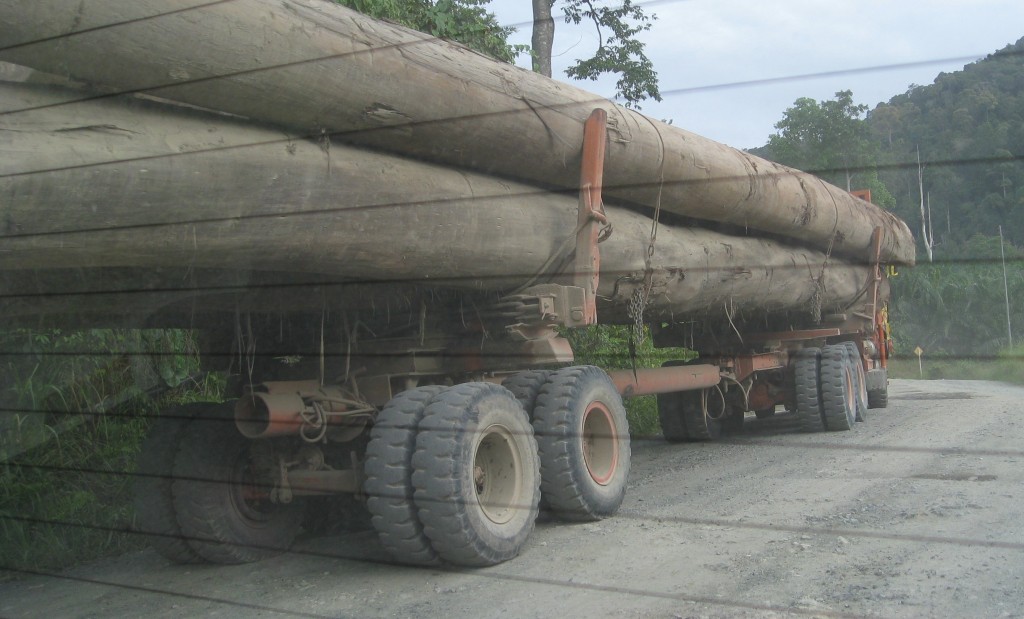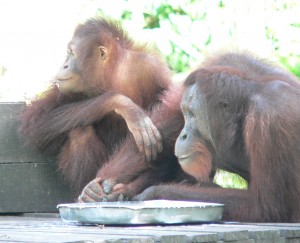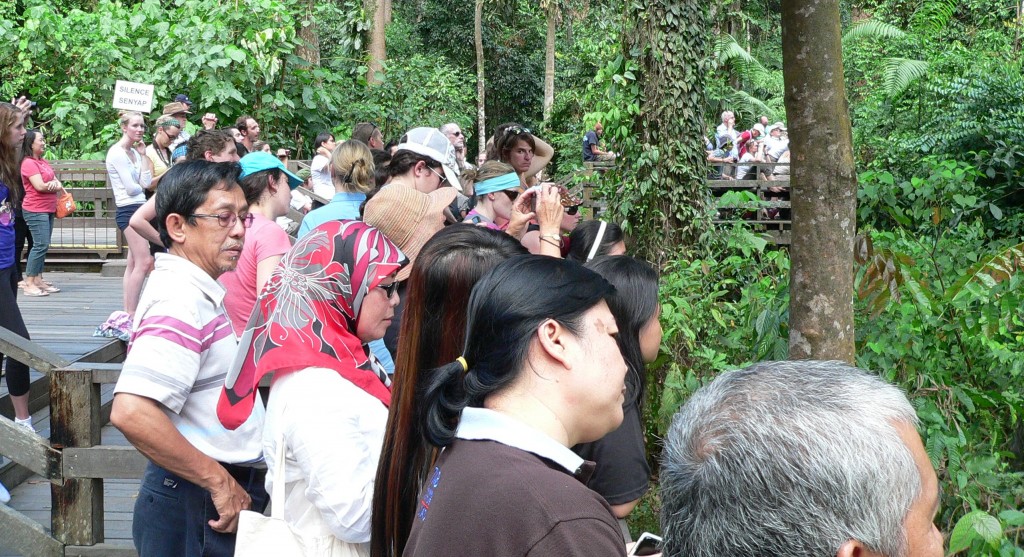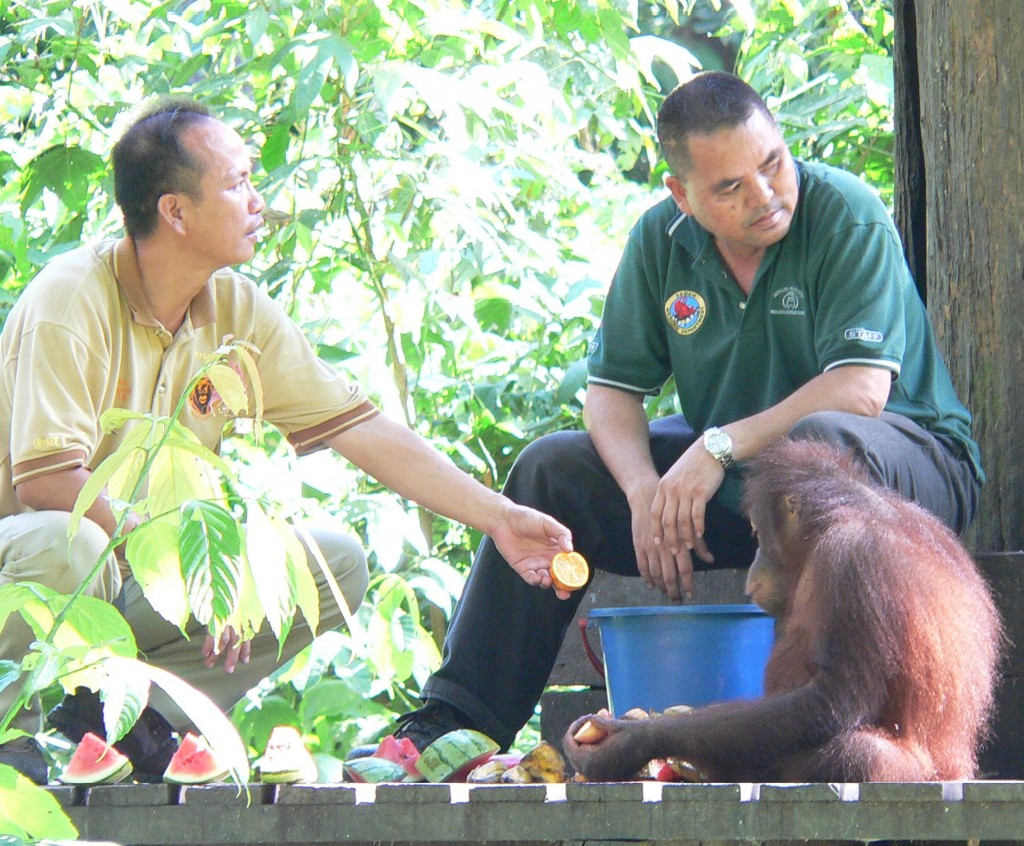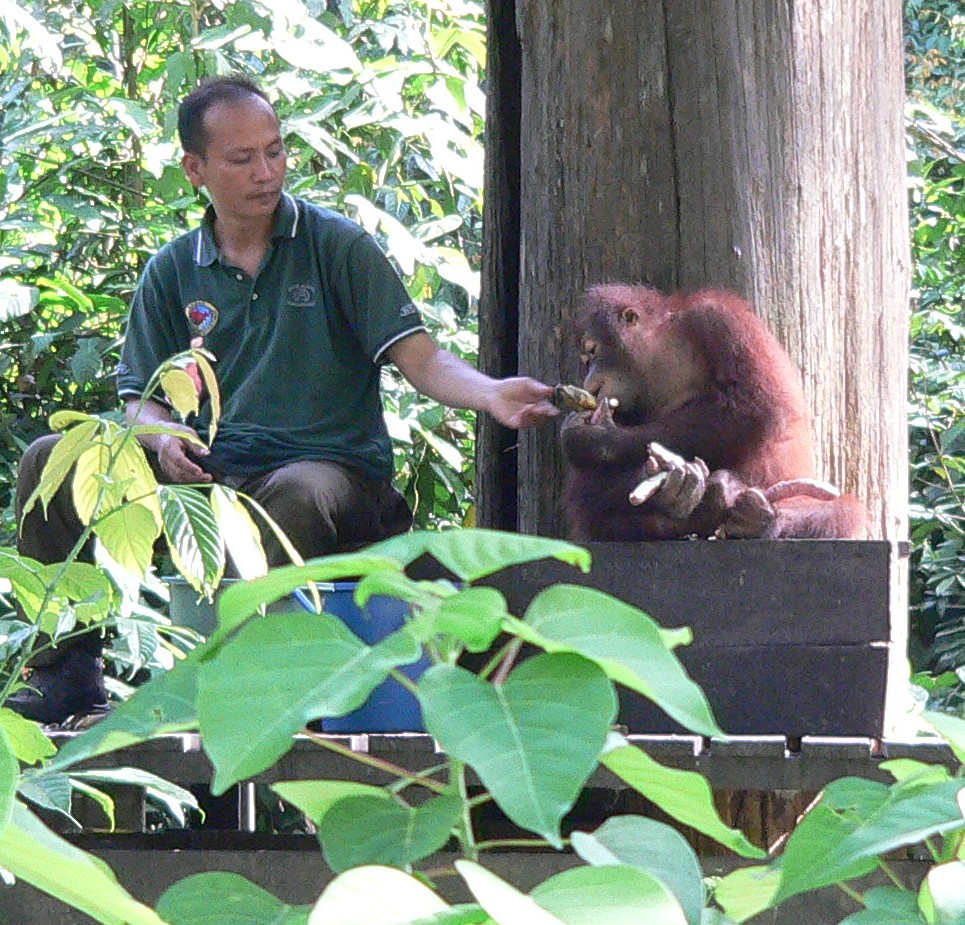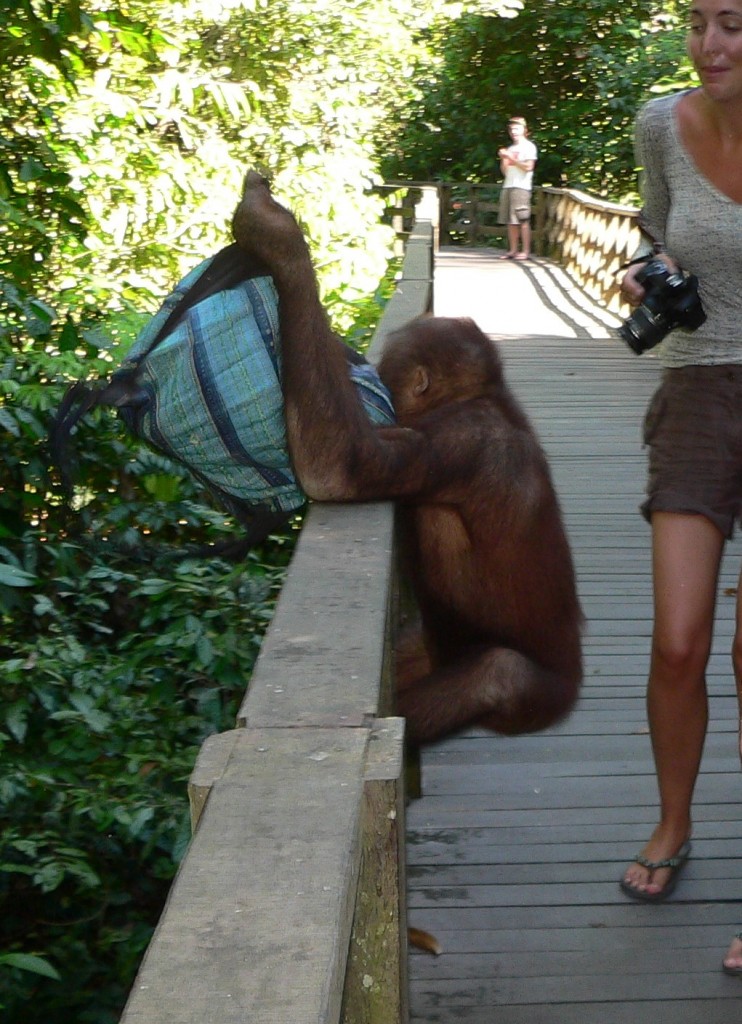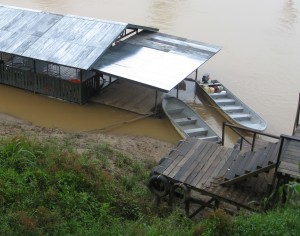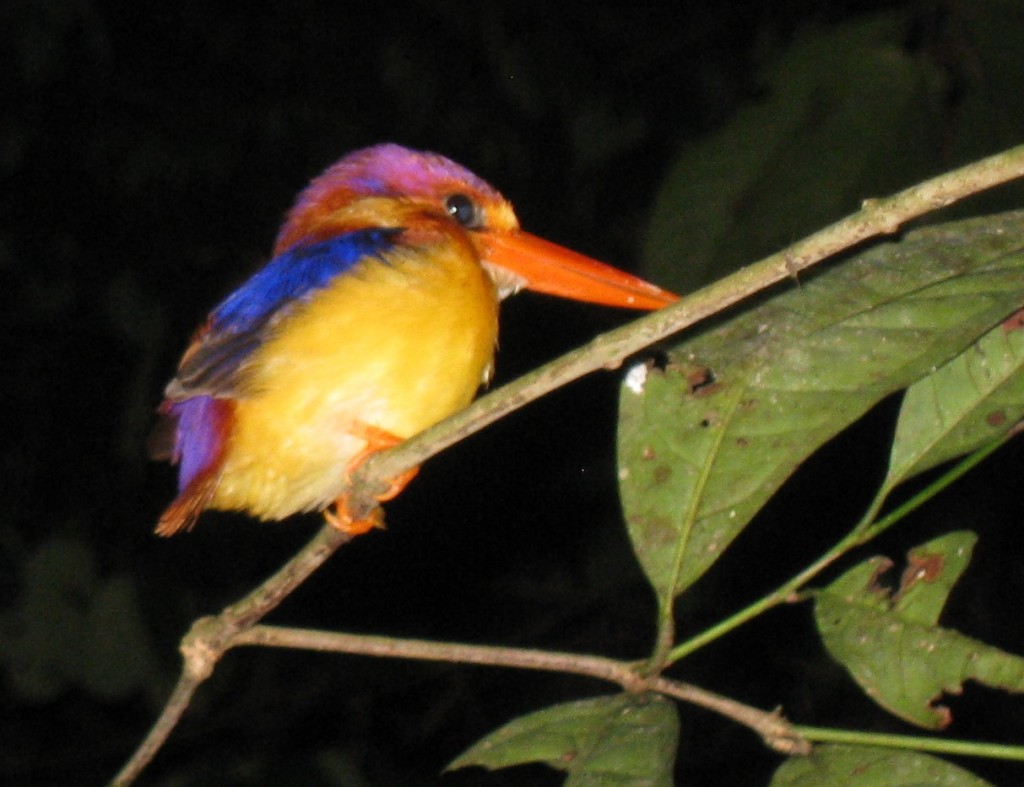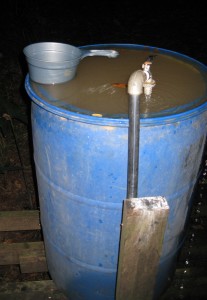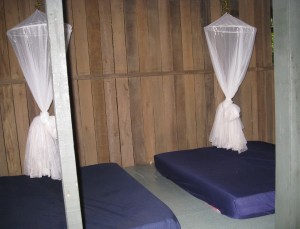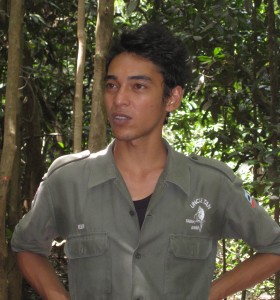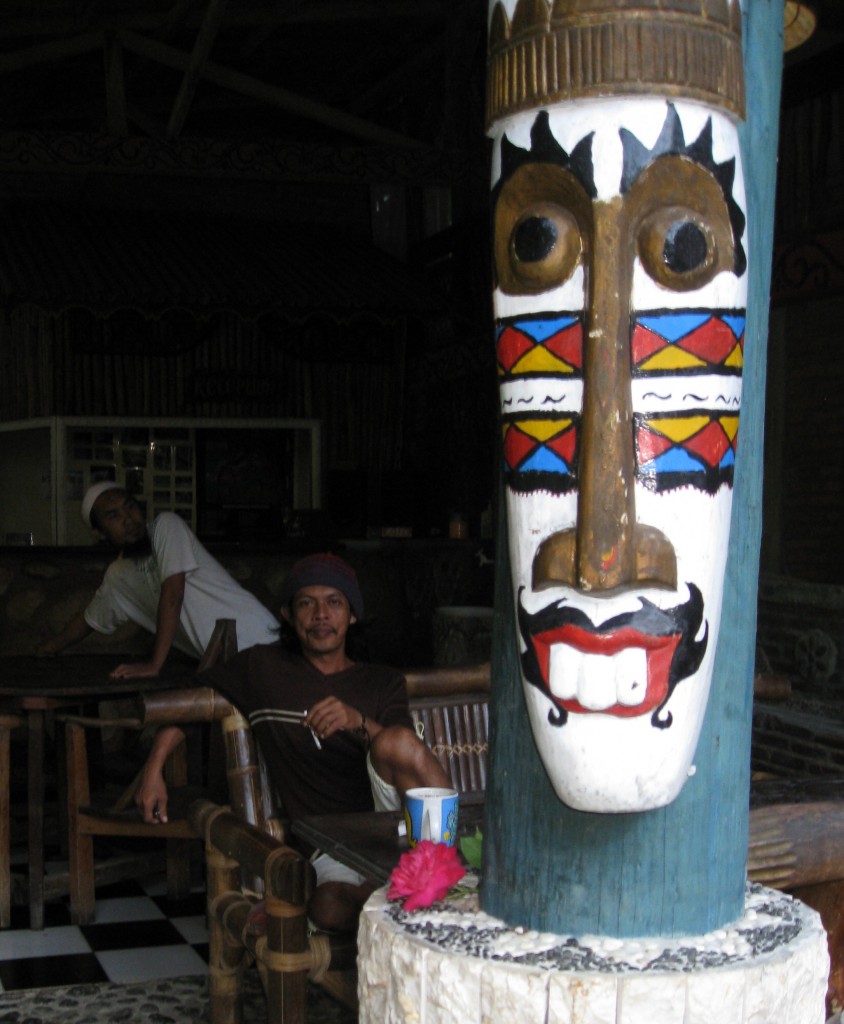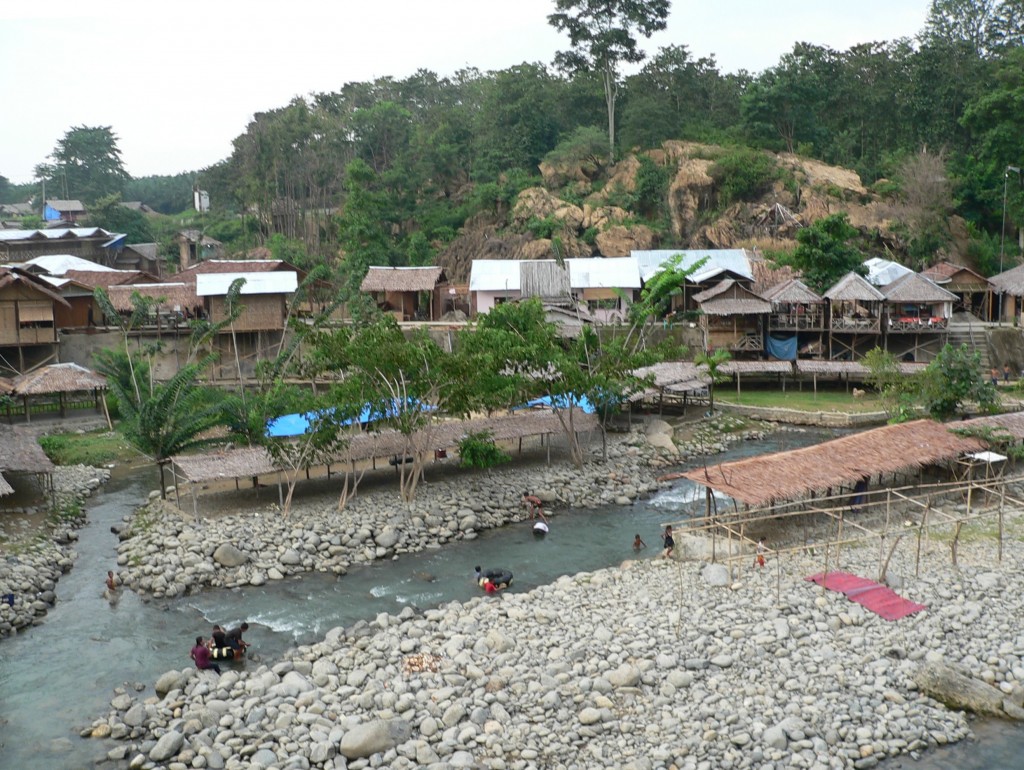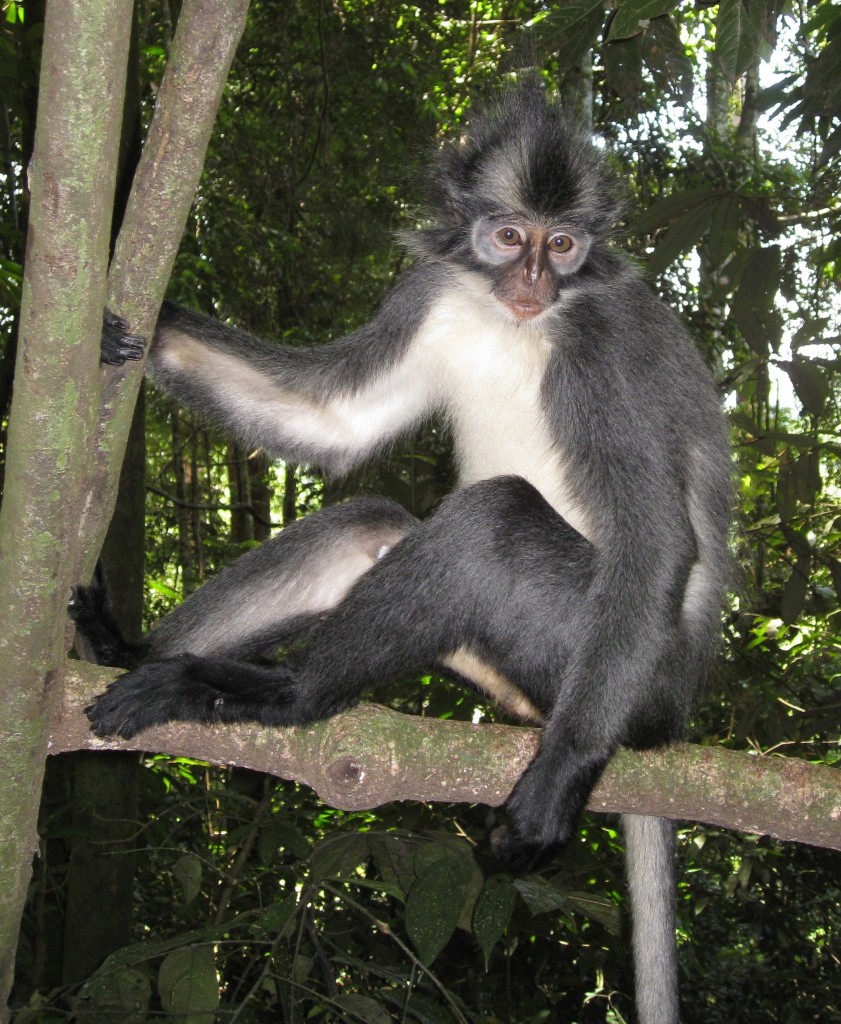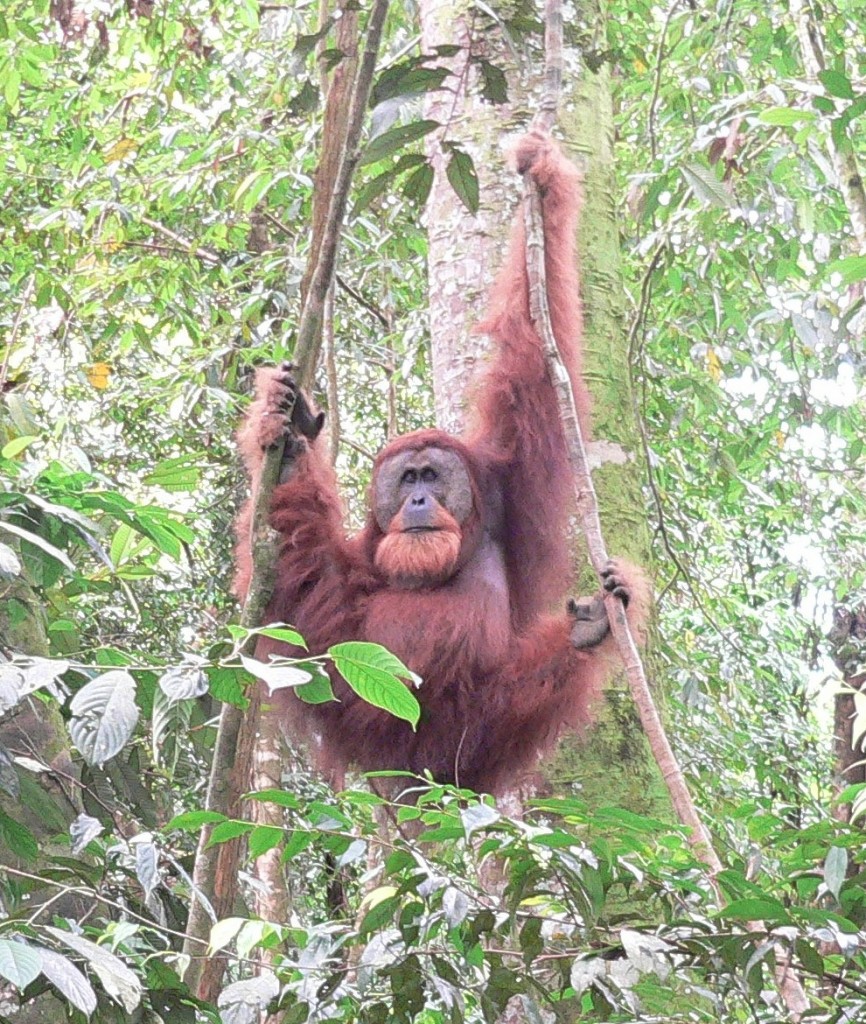This post on Google News and on the syndicated site BasilandSpice.
On my Asian quest to see wild and semi-wild orangutans, I wasn’t sure I’d find a single one of the red apes roaming free in a forest. Orangutans used to be widespread in Southeast Asia, but now survive only on the islands of Borneo and Sumatra. Orangutans on both islands are in serious trouble. Only 6500 Sumatran orangutans (Pongo abelii) survive in the wild. The World Conservation Union lists the Sumatran species as “critically endangered” on their IUCN Red List. Sumatran orangutans are considered one of the world’s 25 most endangered primates.
The Bornean orangutan (Pongo pygmaeus), with around 45,000 individuals left in the wild, is also on the IUCN Red List, as “endangered.” The IUCN predicts that both orangutan species will be extinct in 10 to 30 years if no progress is made in overcoming the threats to their survival. The biggest threat is habitat loss, due to the conversion of forests to palm oil plantations. Road networks often fragment the forests that are left standing. These two factors are responsible for the loss of more than 80% of orangutan habitat in the last 20 years, and the rate of loss is not slowing. Poaching is another major threat to orangutan survival – mostly for the pet trade. According to SOS, there’s a huge local, national, and international demand for infant orangutans to be kept as pets. To capture an infant, poachers usually kill the mother.
Logging trucks roar past as we enter the reserve
Since I was determined to spot some orangutans, hopefully wild ones, I chose my Asian destinations accordingly. I chose Danum Valley Conservation Area in northern Borneo because it’s one of the largest and best-protected lowland rainforests remaining in southeast Asia. The 438 sq km reserve is said to be one of the best places in the world to see truly wild orangutans in their natural habitat. An expensive option for staying in Danum Valley is Borneo Rainforest Lodge. The other choice is the more spartan Danum Valley Field Centre, which is cheaper but gives preference to researchers (which I was not). DVFC is promoted as the leading rainforest research center in the Old World tropics. Tourists can stay at DVFC in limited numbers, but there are no guides. So you’re on your own on the forest trails. I know from experience that having a wildlife guide can make a world of difference in what I see while forest trekking.
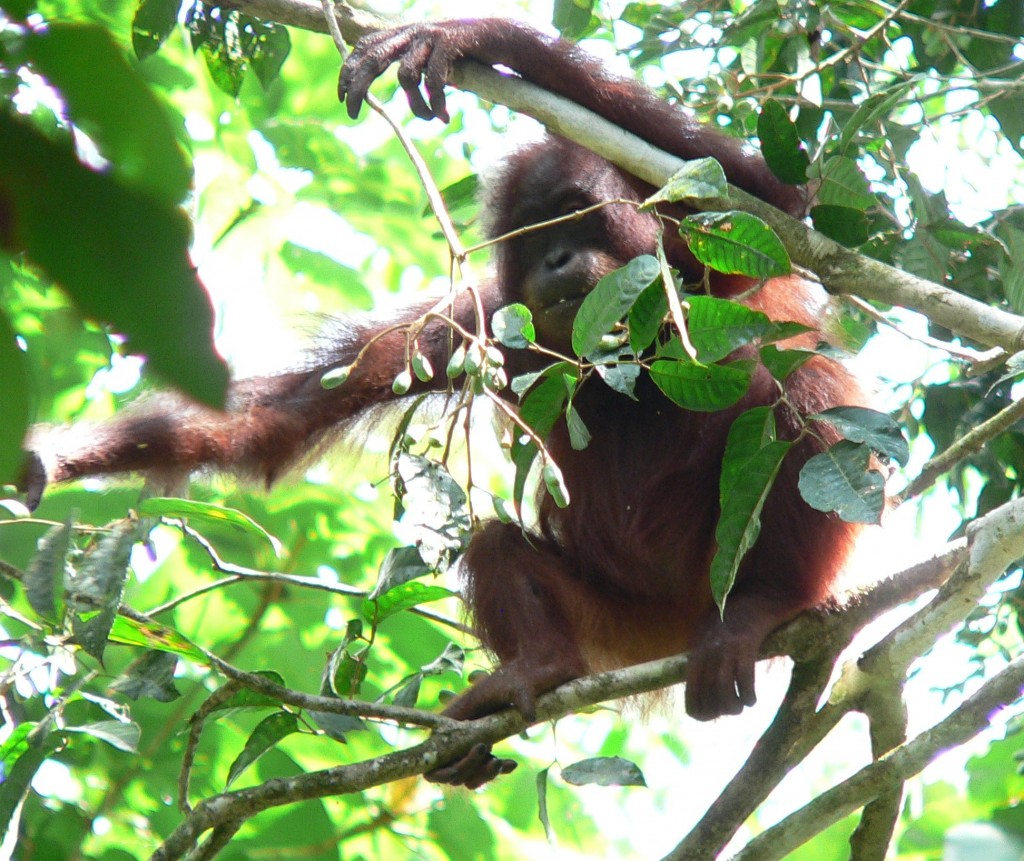
The first wild orangutan I saw, at DanumValley Field Centre (Borneo). You can see the small green fruit she was eating, still on the twigs in front of her right arm, and a tiny piece in her mouth. Photo by Sally Kneidel.
In spite of not having a guide, I saw my first wild orangutan at DVFC. She was busy eating nut-like fruits in a tree overhead, dropping the inedible pieces like rain all around me. I was thrilled, and riveted, my head tilted back so far that my neck ached. But I couldn’t look away from her. I was surprised at how red she was, how long her hair was, and that she seemed unconcerned about my presence. I saw her on several different days in the same tree. I was lucky to see 4 or 5 other orangutans at DVFC too, but those were just fleeting glimpses through dense foliage. I would have seen more with a guide, no doubt, but that was okay. With hours of trekking on the trails, I also came upon lots of long-tailed macaques, pig-tailed macaques, a “flying lemur,” and a troop of gorgeous red leaf monkeys (maroon langurs). And a Borneo pygmy elephant! …just as its rear end disappeared into the undergrowth. Danum Valley was definitely worth my 5-day stay. I’d go back there in a flash.
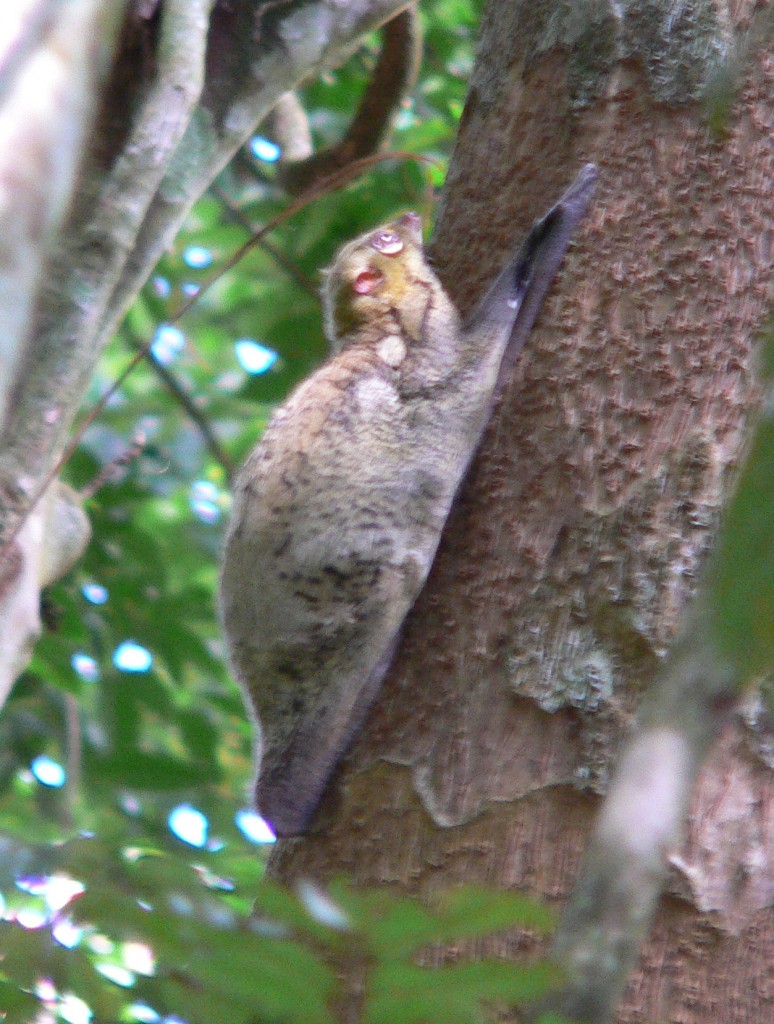
A "flying lemur" clinging to a tree at DVFC. They are unrelated to the true lemurs of Madagascar. Photo by Sally Kneidel.
Although the Danum Valley Conservation Area is rich in wildlife, it is unfortunately bordered on every side by 3-100 km of commercial forests that are rapidly being logged, and beyond those are palm-oil plantations. The road to DVFC is a forestry road; we passed 10 to 12 trucks loaded with huge tree trunks on the way to the Field Centre. That was depressing.
My next stop, Sepilok: workers lax about protecting orangutans
Before I left home, I booked a room near Sepilok Orangutan “Rehabilitation” Center because it was the one place I felt assured of seeing an orangutan, if all else failed. Sepilok is the second most visited tourist attraction in Malaysian Borneo, just after Mount Kinabalu. Its appeal is an orangutan feeding platform in a forest setting, where a worker sets out fruit and a pan of milk twice a day for the few orangs that live there.
I also saw a tourist at the center with an orangutan in her lap, cheek to cheek, while her friend snapped photos. No one who worked there paid any attention. The one Sepilok orangutan that I saw fairly close, on the boardwalk to the viewing platform, had a serious eye problem that appeared to be a bad infection – the eye was swollen shut. Contracted from a cheek-to-cheek encounter with a tourist? Could have been. Had I known in advance that I would see orangutans elsewhere, I would have skipped Sepilok. Although I have to admit the spectacle of 100+ chattering tourists packed onto the sweltering viewing platform was interesting in itself. One person collapsed with heat stroke while I was there, losing control of her bowels. She lay prostrate for a half-hour, then was slowly escorted out, still woozy. I noticed the next day that no one had cleaned off the boardwalk, and the excrement was still there. Not exactly careful health protocol, for barefoot visitors or the macaques and orangs that use the boardwalk when the crowds are gone.
Next, a painful boat ride to a swamp hut
After reading on Lonely Planet’s “Thorn Tree travel forum” about orangutans along Borneo’s Kinabatangan River, I booked a 3-day stay at Uncle Tan’s Jungle Camp on the river. Getting there requires an hour-long van ride followed by a 2-hour boat ride. The boats are small, open motor boats with backless metal benches – not the most comfortable. Especially if you’re prone to lower-back pain like I am.
The schedule includes hours of boat rides every day, looking for wildlife. I did see one orangutan, and 3 other primates that were all new to me: proboscis monkeys, Bornean gibbons (gray gibbons), and a silvered leaf monkey. Nice, but all were too far away to photograph. From the boat, we also saw crocodiles, long-tailed macaques, Oriental pied hornbills, a black hornbill, a “leopard cat,” a common palm civet, a flying fox (a huge bat), a buffy fish-owl, etc. The night walk with our excellent guide Remy was great; he pointed out colorful birds sleeping on low branches right beside the trail, such as a rufous-backed kingfisher, scarlet-rumped trogon, and a little pied flycatcher.
I’ve heard the accommodations at Uncle Tan’s described as “substandard.” I guess I agree with that. The doorless open-air huts were on stilts in a swamp, furnished only with mattresses on the floor and mosquito netting. No pillows…but the sheets were clean. The only water available for ablutions was river water that the guests had to ladle out of a barrel, next to the pit toilets. When I read about this in advance, it sounded rustic and adventurous. In reality, it wasn’t that pleasant. The frequent and long boat rides, while they did give me new primate sightings, grew wearisome. I hate to be a wimp, but I wouldn’t go back there and probably wouldn’t recommend Uncle Tan’s except for the hardiest of travelers. Not for naturalists interested in photography. The brightest star of my stay was Remy the guide, who gave me a lot of information about deforestation in the area when I asked. He said 70% of the Kinabatangan River is bordered by palm-oil plantations that come right up to the river, and he showed me a map to prove it. That was distressing news, but didn’t surprise me.
I let out an expletive of shocked delight
I hit the wildlife jackpot on the island of Sumatra, with a fantastic orangutan experience in Gunung Leuser National Park. GLNP is one of the most famous parks in Asia for travelers and scientists. The park has been recognized internationally as a Biosphere Reserve, a World Heritage Site, and an ASEAN Heritage Park. It’s a huge park, with 10,946 sq km of mountainous and lowland forests, swamps, and mangroves, and is home to four big Asian mammals: Sumatran orangutans, Sumatran tigers, Sumatran elephants, and Sumatran rhinos, plus a number of other primates. The jungle village of Bukit Lawang is right across the Bohorok River from the entry to the park so I bunked in the village, while trekking during the day on the park’s steep jungle trails. Expedition Jungle arranged my lodging at Sam’s Bungalows, provided transport to and from the airport in Medan, and provided guides for the jungle treks.
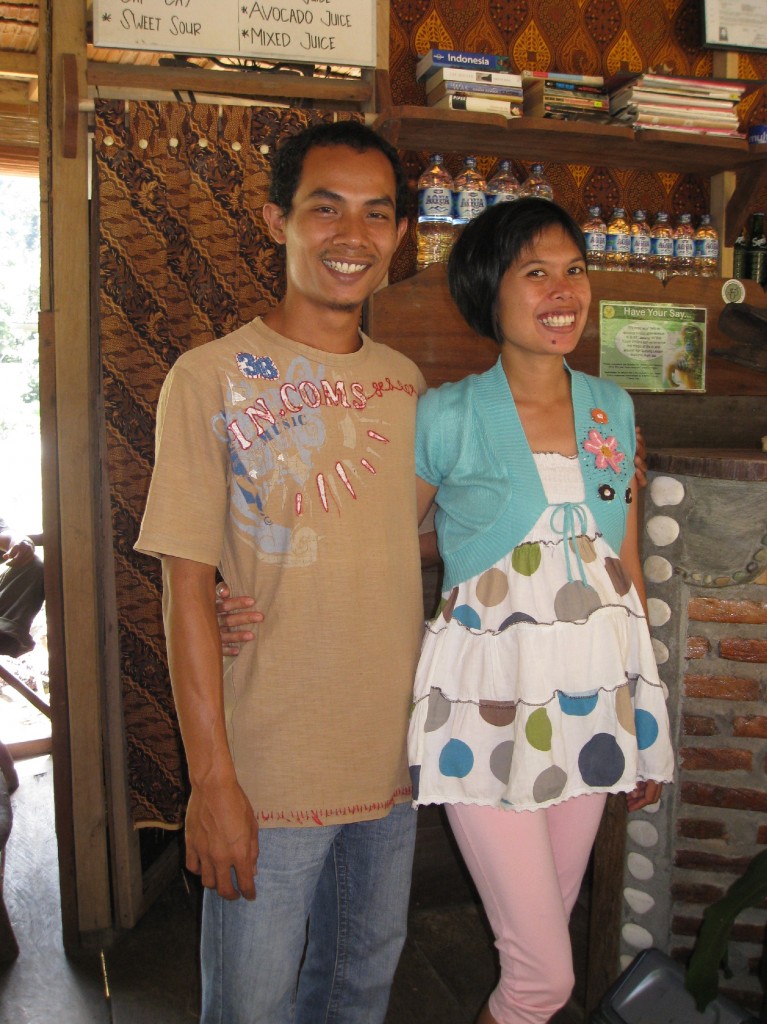
Sam and wife Ipat in their guesthouse, Sam’s Bungalows. They were a joy, and their restaurant had the best food I had anywhere on the trip. Photo by Sally Kneidel
On the first day trekking, we’d been going straight uphill for some time on a jungle trail, when all of sudden we came upon a mother and baby Thomas’s leaf monkey in a tree right next to the trail. The youngster fled, but the mother sat and watched us for several exciting minutes.
An hour later, we were still farther up the mountain when I heard the guide, up ahead of me, calling my name quietly but urgently. I ran up the trail over a little hill and right in front of me, 30 feet from the trail, was a gigantic adult male orangutan gazing my way, perched between two saplings. I had not seen an adult male before in the wild and I was stunned by his size, his huge volume of shaggy red hair, the breadth of his face, the size of his huge hands and feet – the whole scene was mind-boggling.
I let out an expletive of shocked delight and began groping for my camera, unable to take my eyes off of him. Was he the best thing I’ve ever seen? Maybe. Except for the first time I laid eyes on my own children.
Which was best?
If I had to recommend one place to look for orangutans, it might be Gunung Leuser National Park (we also saw several white-handed gibbons there). Bukit Lawang is a fascinating town to use as a base (more about that in a later post), but it’s not the only village with access to the park. Berastagi is another one.
I know some guide books recommend Tanjung Puting National Park in southern Borneo as the best place for orangutan-viewing. And it might be – I don’t know. I didn’t go there because it was too hard to make arrangements by email (I tried), and the prospect of living on a tiny boat (a klotok) for several days didn’t really appeal to me. Linda Spalding wrote a great memoir (A Dark Place in the Jungle) about her klotok trip up the Sekonyer River in Tanjung Puting.
I’ll be writing more about all these places, and about the challenges to orangutan survival. After seeing our furry red relatives in their natural habitat, I feel more intrigued than ever to learn what can be done to protect them. Stay tuned.
Sources other than the links within the post:
Tamara Thiessen. 2008. Borneo: Sabah, Brunei, Sarawak. Bradt Travel Guides, UK.
Myers, Susan. 2009. Birds of Borneo. Princeton Field Guides.
Rowthorn, Chris. 2008. Borneo. Lonely Planet.
Williams, China et al. 2008. Southeast Asia on a Shoestring. Lonely Planet.
Great sources of information about orangutan conservation:
Sumatran Orangutan Society
Orangutan Outreach
Save the Orangutan
ProFauna Indonesia
TRAFFIC: the wildlife trade monitoring network
Greenpeace International
Key words: orangutan Borneo Sumatra deforestation palm oil plantations Indonesia Malaysia primates habitat loss pet trade Danum Valley Sepilok Uncle Tan Gunung Leuser Bukit Lawang
